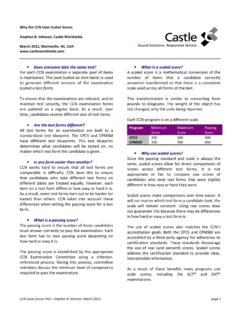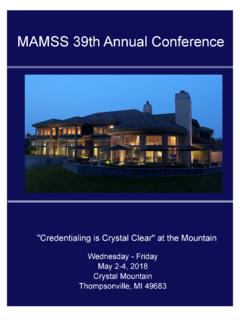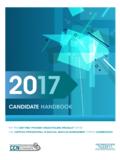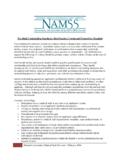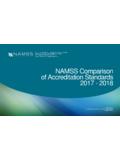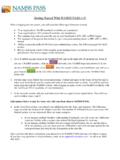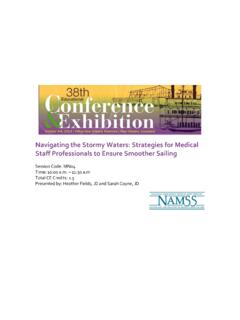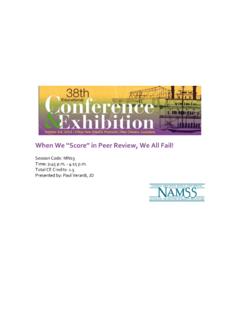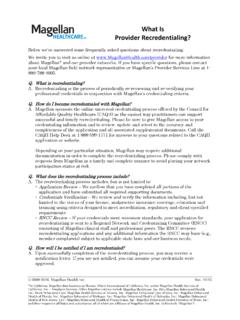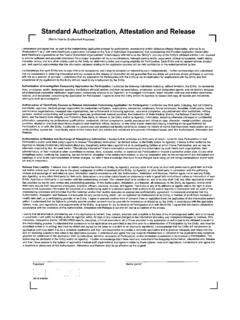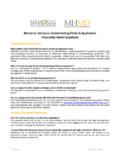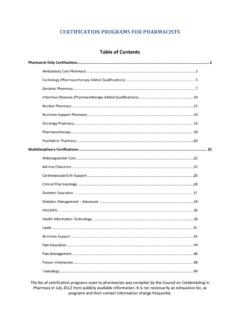Transcription of NAMSS Payer Credentialing Industry Roundtable …
1 NAMSS Payer Credentialing Industry Roundtable report May 2015 Background Following on the success of the 2014 Roundtable discussion regarding facility Credentialing , the National Association Medical Staff Services ( NAMSS ) convened a Roundtable on May 7, 2015, of notable Industry representatives to introduce and discuss the essential data elements for practitioner Credentialing with Payer organizations. At present, practitioner Credentialing , while required within multiple areas of the healthcare Industry , is time-consuming, inefficient, and depletes resources that would otherwise be available to deliver higher quality patient care. NAMSS has identified and vetted the essential data elements to recognize where standardization would create a more efficient and effective process. NAMSS assessment includes a thorough review of the current Credentialing system to identify efficiencies and deficiencies.
2 The Payer Credentialing Roundtable participants represented the following 13 entities: Aetna, Cigna, Kaiser Permanente, Blue Cross Blue Shield of Michigan, Health Net, Horizon Blue Cross Blue Shield of New Jersey, the American Hospital Association, the American Medical Association s Organized Medical Staff Section, the Council for Affordable Quality Healthcare, the National Committee for Quality Assurance, the Medical Group Management Association, and the Health Resources and Services Administration. Essential Common Data Elements for Payer Credentialing 1. Proof of Identity NPI number Social Security Death Master File Date of Birth Verifying a practitioner s identity ensures that the practitioner requesting participation as part of a health plan network is legally able to provide medical care to the health plan members.
3 Proof of identify also reduces the risk of fraud, waste, and abuse. Use of the date of birth and query of the NPI number and the Social Security Death Master File can be used to verify an applicant s identity. Primary Sources: NPI number, Social Security Death Master File 2. Highest Level of Training Complete list (domestic and foreign) of medical school, training programs, internship, residency, and fellowship enrollment and completion dates, as well as clinical degrees and other relevant experience in MM/YY format Practicing specialty completion status (residency or fellowship) Explanation of any time gaps greater than 180 days Complete list of Board-specialty certifications held including original dates; recertification dates; and participation, if applicable, in Maintenance of Certification.
4 All listed education and training entities that confirm training or education must include start and end dates. Applicants are required to submit a written explanation of any time gap greater than 180 days. Time gaps shed light on details of an applicant s education and training experience that are not explicit in self-reported materials. Explanations of these gaps, or lack thereof, may provide insight into an applicant s past that may be critical to the Credentialing decision/recommendation. Applicants should also submit a written explanation of any instances of discipline, suspension, probation, or reprimand. The highest level of training must be verified by the primary source or an approved equivalent source. Primary Sources: May include but should not be limited to state regulation and applicable professional and training schools or residency training programs, American Board of Medical Specialties, ABMS display agents, AMA, AOA, state medical boards.
5 3. Professional Licensure Complete list and/or copies of all professional licensure including the issuing state, license type, license number, status, and issue and expiration dates The applicable state licensing agencies verify the validity, dates, and status of licenses listed on an application. Licenses allow practice within the scope of each license held. MSPs should also query the Federation of State Medical Boards (FSMB) for any unreported licenses. MSPs should directly investigate surrendered licenses or license sanctions, restrictions, revocations, suspensions, reprimands, or probations by a licensing entity, if applicable, or the National Practitioner Data Bank (NPDB). Applicants should also submit a written explanation of any instances of discipline, suspension, probation, or reprimand.
6 Primary Sources: State licensing boards and FSMB. 4. DEA Registration and State DPS and CDS Certifications Complete list and/or copies of DEA, DPS, and/or CDS certificates including issuing state, status, registration number, and issue and expiration dates DEA address for the state currently practicing Coverage arrangements when pending a DEA, DPS, and/or CDS certificate for the state currently practicing Change of address validation The applicable registration agencies verify the validity, dates, and status of prescribing licenses listed on an application. Licenses allow prescribing within the scope of each prescribing license held. MSPs should directly investigate surrendered prescribing licenses or prescribing license sanctions, restrictions, revocations, suspensions, reprimands, or probations by a prescribing licensing entity, if applicable, or the National Practitioner Data Bank (NPDB).
7 Applicants should also submit a written explanation of any instances of discipline, suspension, probation, or reprimand. Primary Sources: DEA, National Technical Information Service, state DPS, state CDS. 5. Affiliation History Complete list of current hospital affiliations including dates of affiliation and status of admit privileges Complete list of coverage arrangements in place when no admit privileges are in effect or when call coverage is required Attestation of the practitioner s current affiliation history or attestation of coverage arrangements ensures health plan members will be able to be admitted to a hospital. Primary Sources: Applicant attestation, Verification from the affiliation, Roster from the affiliation obtained within 180 days of the decision, NAMSS PASS.
8 6. Work History Chronological, comprehensive list of all locations in which a practitioner has worked ( academic appointments, practice groups, surgery centers, etc.), including start date, employment or staff status, and end date for at least the past 5 years Explanation of any time gaps greater than 180 days (if a gap is greater than 1 year the explanation must be in writing) in accordance with NCQA standards Written explanation for any instances of discipline, suspension, probation, or reprimand Military Service DD214 A practitioner s application and resume/curriculum vitae should be initialed by the MSP to confirm no gaps are identified. Obtaining a complete work history is ideal, but MSPs should verify at a minimum the past 5 years of work history. Primary Sources: Applicant attestation, practitioner s application, curriculum vitae, NAMSS PASS, verification from applicable facilities, Military DD214 form.
9 7. Sanctions Disclosure Federal and state, if applicable Temporary and permanent sanctions or licensure restrictions are relevant. Explanations should accompany any sanctions from certifying boards, payers, CMS, or licensing agencies. NPDB s Continuous Query issues alerts for new and monthly reports of all CMS sanctions, federal sanctions, state sanctions, and restrictions on licensure, certification, or scope of practice. The Office of Inspector General s (OIG) List of Excluded Individuals/Entities (LEIE) maintains and provides monthly updates on practitioners currently barred from participating in CMS and/or other federal healthcare programs. The System for Award Management (SAM) monitors federal agency debarments, including those from OIG. Monitoring sanctions is an ongoing process between Credentialing cycles.
10 Sanction checks are to be conducted at initial Credentialing , re- Credentialing , and within 30 calendar days of the published report date. When reporting entities do not publish sanction information on a set schedule the organization must query for the information at least every six months. When a reporting entity does not release sanction information reports, individual queries must be conducted12-18 months after the last Credentialing cycle. Primary Sources: NPDB, OIG, SAM, FSMB, Medicare Opt-Out. 8. Credentialing Application Reasons for inability to perform the essential functions of the position, with or without accommodation. Lack of present illegal drug use. History of loss of license and felony convictions. History of loss or limitation of privileges or disciplinary actions.

